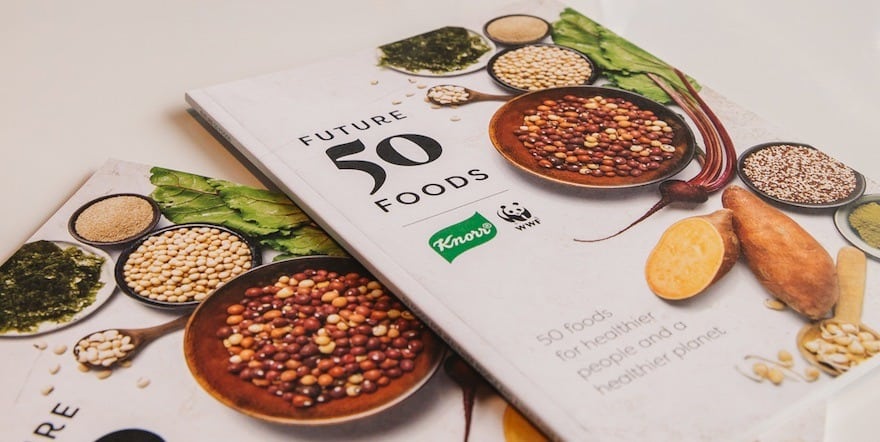The need to change our diet in response to climate change and population growth
Sustainable diets according to the FAO (Food and Agricultural Organization) are diets with a low environmental impact that contribute to food security, nutrition, and a healthy life. “Sustainable diets protect and respect biodiversity and ecosystems, are culturally acceptable, accessible, economically fair and affordable; nutritionally adequate and healthy.”
As noted by Dr Tony Jupiner, “most of us might think that our choices regarding energy or transport cause the most severe environmental damage. In fact, it is our food system that has the greatest impact.”
Indeed, the primary reason we need to change our diet is the environment. 75% of the genetic diversity of agricultural plants has been lost over the past 100 years. This is due to the fact that our diet is not varied enough. The report tells us that 75% of the world’s food comes from only 5 animal species and 12 plant species. Rice, corn and wheat account for more than 60% of plant-derived calories in the overall human diet.
By 2050, the global population is expected to reach 10 billion people. To combat famine, we should focus on a more sustainable diet. The cultivation of the foods proposed in the report has higher yields than current crops. In short, not necessarily eating less, but rather eating better.
Many sources of nutrients are excluded from our diet. Indeed we do not consume enough vitamins and minerals. In this respect, the WWF report tries to encourage a positive change by offering consumers more food choices.
With the future climate also uncertain, the report highlights crops that could be grown in arid conditions, able to withstand extreme heat or, conversely, severe cold, for example.
For all these reasons, WWF has listed the 50 foods of the future that we should embrace and make the most of. These foods have less impact on the planet than animal-based foods, are affordable and accessible, and taste good.
The 50 foods of the future according to The Future 50 Foods
The report is divided into 10 food categories. Let’s explore them!
Seaweed
Rich in nutrients, seaweeds are essential to our existence on the planet (notably for their contribution to oxygen production). The report highlights two particular types of seaweed: Porphyra umbilicalis (nori) and Undaria pinnatifida (wakame).
Nori seaweed is typically used for maki rolls. It is rich in vitamin C and does not require pesticides or fertilizers. Wakame seaweed, for its part, has long been cultivated in Korea and Japan. It is one of the rare sources of omega-3 fatty acids, which are usually found in fatty fish. It is also a source of a wide variety of vitamins and minerals.
Beans and legumes
Their cultivation is good for the environment. They are also sources of fiber, protein, and B vitamins
More specifically, you can find the Japanese red bean, the common bean, broad beans and fava beans, the bambara groundnut or earth pea.
Cacti
Given their development in arid climates, cacti are an interesting source of nutrition if the climate becomes harsher in the future. These cacti contain large amounts of vitamins C and E, carotenoids, fiber, and amino acids. The report, for example, recommends consuming prickly pear pads.
Grains and seeds
This category already represents our primary source of food. However, it is important to diversify consumption by prioritizing foods such as amaranth, buckwheat, eleusine, white fonio, or quinoa to provide better nutritional value and improve soil health.
Fruits and vegetables
Although this category may seem obvious, we still do not consume enough fruits and vegetables. They are rich in vitamin C and fiber while being low in calories. The report highlights squash and tomatoes.
WWF particularly emphasizes that leafy greens, such as broccoli rabe, moringa, or spinach, are the most versatile and nutritious of all vegetables.

Mushrooms
These foods grow in places where other foods could not. Mushrooms, such as Lactarius deliciosus, the clustered polypore, and the velvet-footed collybia, are rich in vitamins B and D, protein, and fiber.
Nuts
Often called “the best foods”, nuts are high in protein, vitamin E, and fat. The report specifically cites cultivated flax, sesame, and walnut.
Root vegetables
These correspond to a plant’s underground organs. Their cultivation is resilient during cool seasons, and they store well after harvest. Root vegetables, such as Spanish salsify, parsley root, and daikon (white radish), contain many vitamins and minerals.
Sprouts
Although they present a risk of bacterial proliferation, their nutrient content is extremely high. Chickpeas and cultivated alfalfa are part of this category.
Tubers
Eating less common tubers makes our food system more resilient. Foods like sweet potato or lotus root are rich in carbohydrates.
This is indeed only a non-exhaustive list. Furthermore, some of these foods remain difficult to find at the moment. But this report allows us to see that it is possible and necessary to eat differently, in a richer and more sustainable way.



